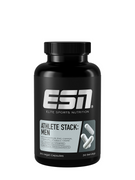Die vier Schritte der Verdauung
Wenn wir etwas essen, so führen wir es über den Mund zwar in unseren Körper, strenggenommen ist es dadurch aber immer noch außerhalb des Organismus. Ähnlich wie eine Creme auf die Haut zwar aufgetragen wird, aber im Anschluss noch einziehen muss, führen wir Nahrung unserem Verdauungsapparat zu, die jedoch aufgenommen werden muss, um am Ende nicht in der Toilette zu landen.
Vereinfacht können wir zwischen vier Schritten der Verdauung unterscheiden, die kurz besprochen werden sollen. Ganz zu Beginn ist der Mund zu betrachten. Mit Hilfe der Zähne erfolgt eine mechanische Zerkleinerung der Mahlzeit, was insbesondere dem Magen hilft, seine Arbeit zu erledigen. Man kann sich dies wie mit einem Steak und einem Fleischwolf vorstellen. Wenn das Steak zu Hackfleisch verarbeitet wird, vergrößert sich die Außenfläche der Fleischmasse um ein Vielfaches.
Darüber hinaus unterstützt der Speichel dabei komplexe Kohlenhydratverbindungen aufzubrechen. Um diesen Effekt tatsächlich zu spüren, müssen wir aber sehr lange auf einem Bissen herumkauen. Einige kennen vielleicht noch den Selbstversuch, wenn man ein Stück Brot in der Schule so lange kauen sollte, bis dieses süßlich schmeckt. Meist produziert man im Zuge dieses Versuchs so viel Speichel, dass der Nahrungsbrei schon fast von allein den Hals hinuntergleitet, noch bevor man die Veränderung wahrnehmen kann.
Vom Mundraum gelangt die Nahrung weiter in den Magen, in dem bekanntlich die Magensäure ausgeschüttet wird. In Kombination mit der Bewegung des Magens wird die Nahrung nun so sehr zerkleinert, dass diese durch eine Öffnung in den Dünndarm gelangt. Diese Öffnung wird Pförtner genannt und hat in etwa die Größe eines Stecknadelkopfes. Theoretisch bedeutet das, dass größere Nahrungsstücke nicht aus dem Magen gelangen können. In der Praxis wird der ein oder andere aber vielleicht schon einmal festgestellt haben, dass im Einzelfall auch schlecht gekaute Erbsen oder Maisstückchen durchaus ihren Weg in den weiteren Verdauungsbereich finden können. Im Großen und Ganzen können wir aber von einer entsprechenden Zerkleinerung der Nahrung ausgehen.
Im Dünndarm erfolgt nun zum Großteil die Aufnahme aller Nährstoffe. Während im Mundraum bereits ein kleiner Teil Kohlenhydrate aufgenommen werden kann, wenn dieser lang genug Kontakt zur Mundschleimhaut hat, und auch im Magen bereits wenige Amino-und Fettsäuren ihren Weg in den menschlichen Körper finden, sind dies alles so geringe Mengen, dass diese in der Literatur oftmals vernachlässigt werden. Der Dünndarm ist also die entscheidende Station, wenn es um die Verdauung bzw. die Nährstoffaufnahme geht.
Bei der Aufspaltung der Nahrung unterstützt den Körper nicht nur die Magensäure, sondern auch eine Reihe an Enzymen oder die Galle. Wird beispielsweise zu wenig vom Enzym Laktase produziert, wird der Milchzucker Laktose nicht vollständig gespaltet und nicht aufgenommen.
Darüber hinaus hat der Körper gewisse Grenzen, wie viel er von einem Nährstoff auf einmal aufnehmen kann. Diese Grenzen können sehr unterschiedlich sein, was auch durch die individuelle Länge unseres Dünndarms begrenzt ist. Wie gut der Nahrungsbrei durch unseren Dünndarm gelangt, hängt ebenfalls von Faktoren wie Nährstoffdichte, Wasserhaushalt des Körpers, Gesundheit des Dünndarms oder unserer Bewegung im Alltag ab. Eine Vielzahl an Faktoren, was an dieser Stelle nur verdeutlichen soll, dass unserer Verdauung komplex ist und man bei Problemen nicht den Fehler begehen sollte, sich nur auf einen Punkt zu konzentrieren. Dennoch, soviel sei schon einmal verraten, sollen etwas weiter unten typische Probleme benannt und mögliche Lösungen dargestellt werden.

Was im Dünndarm vom Körper nicht aufgenommen wurde, gelangt in den Dickdarm. Dort leben unsere Bakterien, deren Zusammensetzung so individuell wie ein Fingerabdruck ist. Jeder Mensch hat also eine eigene Zusammensetzung, wobei man aktuell davon ausgeht, dass insbesondere Muttermilch einen großen Einfluss auf die frühkindliche Besiedlung und die Verhältnisse als Erwachsener nimmt. Dennoch nehmen wir auch mit unserer Ernährungsweise und unserem Verhalten Einfluss auf unsere Dickdarmbakterien und länger anhaltendes Fehlverhalten kann zu Problemen wie Durchfall, einem aufgeblähten Unterbauch oder sogar Grippesymptomen führen.
Alles, was auch unsere Dickdarmbakterien nicht verwerten, landet schließlich über kurz oder lang in der Toilette. Unser Stuhlgang besteht also aus unverdauten Nahrungsresten, die Kohlenhydrate, Protein und Fett, aber auch Mikronährstoffe enthalten und vom Körper nicht genutzt werden können. Die Verdauung selbst ist in Wirklichkeit noch deutlich komplexer, aber für ein grundlegendes Verständnis ist diese Darstellung für uns vollkommen ausreichend. Schauen wir uns daher ein paar grundlegende Punkte an, die jeder beachten sollte, der Verdauungsprobleme vermeiden will.
Wie du Verdauungsprobleme vermeidest
Die Ursache für Verdauungsprobleme kann vielfältig sein und insbesondere der Einzelfall kann im Rahmen eines einzelnen Artikels nicht im Detail diskutiert werden. Es gibt aber eine Reihe an Tipps, die jeder Mensch umsetzen sollte, die gleichzeitig aber von vielen Personen vernachlässigt werden. Gehen wir dabei in der gleichen Reihenfolge vor, wie die Nahrung unseren Verdauungstrakt durchläuft.
Das bekannte Brotexperiment wurde bereits angesprochen und verdeutlichte damit gleich einen ersten Tipp, der heutzutage oftmals vernachlässigt wird: Kaue ausreichend! Wer in die Literatur schaut, wird vereinzelnd konkrete Zahlen finden, aber seien wir ehrlich: Wir wollen nicht damit beginnen, beim Kauen noch die Bewegungen unseres Kiefers zu zählen. Eine einfache Lösung für die Praxis gestaltet sich so, dass du so lange kaust, bist die Nahrung durch den Speichel praktisch automatisch in die Speiseröhre rutscht, ohne dass du diese bewusst schlucken musst. Dieses Vorgehen sorgt dafür, dass du deinem Körper die Gelegenheit gibst, ein Sättigungsgefühl zu entwickeln. Darüber hinaus ist die Nahrung so stark zerkleinert, dass der Magen weniger Arbeit leisten muss bzw. seine Arbeit leichter verrichten kann.
Der zweite Tipp bezieht sich auf den Magen und ist etwas komplexer. Wer mit übermäßiger Säureproduktion und Sodbrennen zu kämpfen hat, sollte seinen Säure-Basen-Haushalt überprüfen. Dies gelingt mittels einfacher Teststreifen, die in der Apotheke oder im Internet günstig zu erwerben sind. Während morgens ein gewisser saurer Wert vertretbar ist, sollte der Urin insbesondere nach Mahlzeiten basische Werte annehmen. Diese kurze Beschreibung soll an dieser Stelle in erster Linie darauf hinweisen, wo man bei diesem Problem ansetzen könnte. Die Lösung besteht darin, den Gemüse- und Obstkonsum (deutlich) zu erhöhen oder (bzw. ergänzend) auf ein hochwertiges Basenpulver zurückzugreifen, was nichts anderes als eine Mischung an verschiedenen Salzen im chemischen Sinne ist.
Den Dünndarm können wir auf verschiedene Weisen unterstützen, wobei die Probleme auch vielfältig sein können. Ein Punkt, der von vielen Menschen nicht ausreichend umgesetzt wird, ist Bewegung. Wer sich so häufig wie möglich zu Fuß bewegt, treibt nicht nur seinen Kalorienverbrauch in die Höhe und kann mehr Essen, sondern unterstützt seinen Dünndarm auch beim Verdauungsvorgang, denn der Nahrungsbrei muss durch das fünf bis sechs Meter lange Organ gelangen, damit in den einzelnen Abschnitten unterschiedliche Nährstoffe aufgenommen werden können.

Wer Verdauungsprobleme aufgrund einer geschädigten Darmschleimhaut hat, sollte dagegen auf Glutamin zurückgreifen und morgens zehn bis 15 Gramm auf nüchternen Magen nehmen. Die Zellen des Dünndarms nutzen diese bevorzugt zur Energiegewinnung, was nicht als Verschwendung missverstanden werden sollte. Schließlich kann nur ein gesunder, mit ausreichend Energie versorgter Dünndarm eine möglichst optimale Nährstoffaufnahme sicherstellen.
Die Dickdarmbakterien werden dagegen mit Ballaststoffen „gefüttert“. Es sollten täglich etwa 15 Gramm Ballaststoffe pro 1.000 kcal zugeführt werden, was selbst Menschen, die sich eigentlich gesund ernähren, nicht immer schaffen, da nicht jedes Gemüse reich an Ballaststoffen ist. Zwei Teelöffel Flohsamenschalen pro Tag sind ein leichter Trick, wie man seine Ballaststoffzufuhr erhöhen kann.
Fitnessbegeisterte können allerdings ganz einfach zwei Fliegen mit einer Klappe schlagen: Wer Reis oder Kartoffeln vorkocht und diese über Nacht im Kühlschrank lagert, erhöht automatisch seine Ballaststoffzufuhr. Durch die Zubereitung und die anschließende Abkühlung entsteht sogenannte resistente Stärke. Diese wird im Dünndarm nicht aufgenommen - man spart also ein wenig Kalorien - sondern von den Dickdarmbakterien verdaut.
Die 80-20-Regel als Grundlage einer gesunden Verdauung
Der letzte Punkt zeigte uns, dass Vorkochen nicht nur Zeit, sondern auch Stress erspart und insbesondere ein gutes Stressmanagement ist ein wichtiger Punkt, für eine gesunde Verdauung. Darüber hinaus sind die genannten Tipps nur einige Beispiele, wie man Verdauungsprobleme vermeiden kann. Wichtig ist in diesem Zusammenhang, dass diese auf einer gesunden Grundlage basieren sollten. Dies ist in der Praxis am einfachsten mit Hilfe der 80-20-Regel umsetzbar. Etwa 80 Prozent der Lebensmittel, die man isst, sollten möglichst unverarbeitet sein, wohingegen die restlichen 20 Prozent dazu dienen, dass wir uns auch mal eine Leckerei gönnen können. Ein gesunder Verdauungsapparat verträgt diese genauso, wie ein sportlich aktiver Mensch die eine oder andere Extra-Kalorie ohne Problem verbraucht. Vorkochen spart Zeit, Kalorien und hilft der Verdauung!

Kochen kann unter der Woche eine Menge Zeit beanspruchen, so dass viele Menschen gerne zu Snacks oder Essen vom Bestellservice greifen. Fitnessbegeisterte, die verstärkt auf ihre Ernährung achten, kochen ihr Essen dagegen häufig für einen oder mehrere Tage vor und sparen damit nicht nur Zeit, sondern sogar noch Kalorien und tun ihrer Verdauung etwas Gutes.
Wer Kartoffeln, Nudeln oder Reis kocht und diese anschließend über Nacht im Kühlschrank lagert, sorgt dafür, dass sich sogenannte resistente Stärke bildet. Der Vorgang dauert bis zu 12 Stunden, so dass ein rechtzeitiges Vorkochen tatsächlich einen Unterschied macht. Die in dieser Zeit gebildete resistente Stärke wird im Rahmen der Verdauung im Dünndarm nicht aufgenommen, auch wenn die Kohlenhydratquelle vor dem Essen erneut erhitzt wird. Auf diese Weise spart man ein paar Kalorien, doch das ist nicht alles:
Die resistente Stärke wird im Dickdarm von den dort lebenden Bakterien als Nahrung genutzt, so dass das Vorkochen gleichzeitig positive Auswirkungen für unseren Verdauungsapparat hat. Die Bakterien erzeugen aus der resistenten Stärke kurzkettige Fettsäuren, die wiederum vom Darm zur Energieversorgung genutzt werden. Dies beugt Entzündungen vor und unterstützt eine gesunde Darmflora. Darüber hinaus erhöht resistente Stärke die Sättigung. Ein kleiner Trick mit großer Wirkung, den sich jeder Fitnessbegeisterter zu Nutze machen kann.








